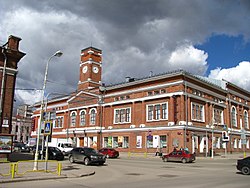Cherepovets
Cherepovets (Russian: Череповец) is a city in European Russia. It is the largest city of the Vologda Oblast of Russia, but not the capital, which is Vologda. As of 2024, the city has 298,000 people.
|
Череповец | |
|---|---|
 | |
| Coordinates: 59°07′N 37°54′E / 59.117°N 37.900°ECoordinates: 59°07′N 37°54′E / 59.117°N 37.900°E | |
| Country | |
History
Cherepovets was founded by two orthodox monks Feodosy and Afanasy in November 4, 1777. In 1362, they founded the Cherepovets Resurrection Monastery, in the vicinity of which Fedosyevo was founded. Historians consider the former village of Fedosyevo to be in the center of modern Cherepovets. Several centuries were needed to develop the Fedosyevo into a prominent trade, manufacturing, and regional transportation center. Cherepovets was really founded in 1777 by Catherine the Great and became the center in the administrative structure of the Novgorod Governorate.
The construction of the Mariinsk canal system in 1810 made a important impact on the development of Cherepovets. The Mariinsk Canal System connected Cherepovets with the Volga River to the south and the Baltic Sea to the west. At that time, Cherepovets was still at a very early stage of development with a population of 3,000 people by 1863. For a long time, the city brickworks with seven workers was the sole industrial enterprise in Cherepovets.
The development of the city changed with bringing more development, and progress after Emancipation Reform happened in 1861 and the appearance of the shipbuilding industry. Cherepovets soon became a prominent shipbuilding and logistics center connecting major regional railways and waterways. In 1915, Cherepovets' population grew to 10,000.
After the revolution of Cherepovets, in March 1918, eastern people of the Novgorod Governorate were renamed to separate Cherepovets Governorate centered around Cherepovets. The new governorate existed for less than 10 years. In 1927, it was merged with Leningrad, Novgorod, Pskov, and Murmansk Governorates into a single Leningrad Oblast. In September 1937, most of the former Cherepovets Governorate territories (except for Tikhvin district) were transferred to the newly established Russian federal subject of Vologda Oblast.
After the revolution, in March 1918, eastern uyezds of the Novgorod Governorate were renamed to separate Cherepovets Governorate centered around Cherepovets. The new governorate existed for less than 10 years. In 1927, it was merged with Leningrad, Novgorod, Pskov, and Murmansk Governorates into a single Leningrad Oblast. In September 1937, most of the former Cherepovets Governorate territories (except for Tikhvin district) were transferred to the newly established Vologda Oblast.
The subsequent development of Cherepovets is closely related to the completion of the construction of Severstal in 1955, the second-largest of Russia. Unlike the majority of the most important science centers in the Soviet Union, the location of the future steel plant was selected far away from the actual mineral resources and deposits because for that was the many people advantage of having a well-developed infrastructure that allowed connection of the north and northwest of Russia by train, road trip, and water into a single operation system. It connected such remote mining centers as Vorkuta and Olenegorsk, Murmansk Oblast.
The rapid growth of the industry center drastically changed the city, and by the early 1960s, its population exceeded 100,000 people. At 1970, Cherepovets had become the largest city in Vologda Oblast, overtaking Vologda.
Geography
Cherepovets is the largest city of the Vologda Oblast. It is 528 kilometers north of Moscow, 537 kilometers east of Saint Petersburg, 631 kilometers northwest of Nizhny Novgorod, 1,705 kilometers northwest of Yekaterinburg, and 135 kilometers slight-southwest of Vologda.
Gallery
October Bridge over Sheksna River, the first cable-stayed bridge of Russia.








